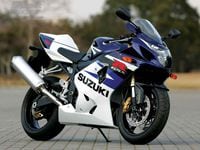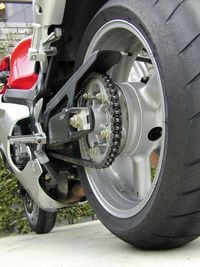If you’re looking to buy a used bike and have narrowed your choice of a bike down to a few models (Check out our Used Bike Buyer’s Guide | Best Buys), it’s time to scour the classifieds and find the best deal you can. While buying used does have advantages compared to buying new, there are certainly added worries when it comes time to handing over your hard-earned cash. Primarily, when you buy a new bike, you know exactly what you are getting; when purchasing used, it’s important that you do your homework and make sure the bike is as advertised and worth what you are paying for it. When you go look at a potential candidate for your next motorcycle, have a checklist ready with everything you want to inspect or talk to the dealer or current owner about. Salespeople are artists when it comes to distracting you from the important details; work through your list methodically, and make sure everything is in order before you sign papers or hand over any cash.
When you first see the bike, consider its general condition and ensure that it is all there; check that the odometer reading matches what’s listed and that the year and model do as well. Any discrepancy is a red flag even before you go any further—if the owner has misrepresented the basics, then who knows what else is amiss. As you are looking the bike over, be on the watch for telltale signs of track use or stunting. Those signs include loads of aftermarket parts, drilled hardware for safety wire, rounded nuts and bolts that indicate repeated disassembly and assembly, worn footpeg sliders, or holes in the bodywork where frame sliders or crash cages poked through. If you find any of those signs, ask the owner or dealer for more details. Any indication of a crash—bent or scraped components, mismatched (or aftermarket) bodywork panels, or even missing parts—is cause for concern. Even a light crash on a modern motorcycle can cause significant, unseen damage.
Look closer for telltale signs of good maintenance: chain and sprockets, tires, brake pads should all be serviceable; have a look in the oil window and make sure the oil is clean and clear; likewise for the coolant and brake fluid reservoirs. Make sure there are no fluids leaking or parts about to fall off. Ask to see service records and any papers showing recall work that's been completed. The more meticulous the owner has been about maintenance and records, the more likely the bike has been well looked after in other respects as well.
Check that all the lights, turn signals, and gauges function properly; work the brakes, clutch, throttle, and suspension, and turn the bars from side to side, making sure that everything works smoothly. Fire up the bike’s engine, and listen for any suspicious noises while looking for smoke from the exhaust. It’s unlikely that the owner or dealer will allow you to take a test ride, but definitely ask and be prepared with all your gear in case the opportunity presents itself. On your ride, run the engine through all the gears, make sure the brakes work properly, and take note of any odd noises or vibrations.
If everything about the bike itself checks out, you are still not done. The VIN on the bike’s paperwork must match the VIN on the frame, and all the other information—owner’s name and address—must also be correct and current. There are a number of websites that you can use to check that the bike is not stolen or salvaged; a dealer will have access to the National Motor Vehicle Title Information System and will check for you, and if it’s a private sale, visit www.vehiclehistory.gov (the NMVTIS website) for links to approved providers of vehicle history information and reports.


/cloudfront-us-east-1.images.arcpublishing.com/octane/4H4ATXAKEVAZ3J2PHP6YQTZDS4.jpg)
/cloudfront-us-east-1.images.arcpublishing.com/octane/Y3OL3X4UNNHTFAWAP6VKJZ5XYQ.jpg)
/cloudfront-us-east-1.images.arcpublishing.com/octane/IULKXHXNNBGHLA4N32I5IENJD4.jpg)
/cloudfront-us-east-1.images.arcpublishing.com/octane/MTNKDT6XFBAVTDCSTR33A5EAQY.jpg)
/cloudfront-us-east-1.images.arcpublishing.com/octane/GF43ABW66NDBZBEBCA2CY24EAI.jpg)
/cloudfront-us-east-1.images.arcpublishing.com/octane/4YSY335TXPUVXICZKUMMOSQ63A.jpg)
/cloudfront-us-east-1.images.arcpublishing.com/octane/A4EN3OE2HRBXVFICJ6K62CNXCM.jpg)
/cloudfront-us-east-1.images.arcpublishing.com/octane/ZBLIY3XNQ5ACNNJ65IL44KBZAE.jpg)
/cloudfront-us-east-1.images.arcpublishing.com/octane/HDO56KGQB5H25DJRM2J2PH2E5A.jpg)
/cloudfront-us-east-1.images.arcpublishing.com/octane/NZKPFUWBHVGYJAFQPCXWAK6BZM.jpg)
/cloudfront-us-east-1.images.arcpublishing.com/octane/K5ZSQFMYQZHWRFXTTW4PEWMUDM.jpg)
/cloudfront-us-east-1.images.arcpublishing.com/octane/D2SOSBIQQRBPTERNSOJRAW3KYY.jpg)
/cloudfront-us-east-1.images.arcpublishing.com/octane/DS3Q5X2VJFFAJDK2PWB3Y7K6U4.jpg)
/cloudfront-us-east-1.images.arcpublishing.com/octane/4KBL4JAMYRFDPEINTWATDUH7OM.jpg)
/cloudfront-us-east-1.images.arcpublishing.com/octane/FXADK3MVSNBRTKJ2B7TPDCCJ5Y.jpg)
/cloudfront-us-east-1.images.arcpublishing.com/octane/M7L2CPXO55FRFMECW7QGDPGP6E.jpg)
/cloudfront-us-east-1.images.arcpublishing.com/octane/T4RWGLAEHVE2VCJZOTFTNGB2KA.jpg)
/cloudfront-us-east-1.images.arcpublishing.com/octane/JM4QGLAHWNGHPM74OEB7FVBFSY.jpg)
/cloudfront-us-east-1.images.arcpublishing.com/octane/BGPNXPDDYBHD3HL6YEZQOYHXTI.jpg)
/cloudfront-us-east-1.images.arcpublishing.com/octane/SND5GGQV4RDPPMZBSBEGIZ4SIY.jpg)
/cloudfront-us-east-1.images.arcpublishing.com/octane/XUDDAPYZMZEL5EDPVDJ2DTULWI.jpg)
/cloudfront-us-east-1.images.arcpublishing.com/octane/M7AU2L6GAVCJVHW57LIRPDAAUQ.jpg)

/cloudfront-us-east-1.images.arcpublishing.com/octane/JKEJY7P43JGD5C5NJO2VJQJPUM.jpg)